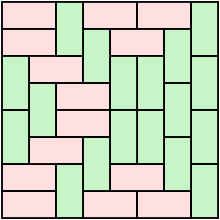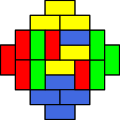雙體模型
在統計力學和圖論中,雙體模型(dimer model)是二維空間密鋪的模型,也稱為骨牌密鋪(Domino tiling,多米諾密鋪)或隨機密鋪模型(random tiling model)。這也是平方格子的完美匹配。[1][2][3][4]

介紹[編輯]
若有 平方格子G、以及 把骨牌,覆蓋數量或密鋪數量是[5][6][1]
例如:
若G是環面,則
。

阿茲特克鑽石與北極圈現象[編輯]
Z也依賴格子的邊界(參看阿茲特克鑽石)。
-
阿茲特克鑽石(Aztec diamond)密鋪,有1024個密鋪
-
一個可能的密鋪
阿茲特克鑽石表示所謂的「北極圈的現象」(Arctic circle phenomena),即邊界看起來很同質(冰凍地區),但是中間的「北極圈」不同質(非冰凍地區)。可以使用高度函數解釋這個現象。[7][4]
http://faculty.uml.edu/jpropp/tiling/www/intro.html(頁面存檔備份,存於網際網路檔案館)
高度函數[編輯]
一個密鋪定義一個0微分形式(函數):
s是自旋(參看易辛模型)、v是頂點。那麼可以定義一個1-形式:
這個形式是閉形式。注意上面的形式不等於0因為G是二分圖。也定義密鋪函數
若雙體e存在,,不然等於0。高度差函數是[7]
這個函數定義一個的隨機函數。這也是閉形式。的確威廉·瑟斯頓表示了若真的是密鋪函數,這是一個必要條件。h是高度函數。
NxN平方格子的高度函數在中間逼近O(N)。但是阿茲特克鑽石的高度函數逼近h的平均值。[7]的確,CKP定理[7]說h最小化一個熵(或熱力學自由能)的泛函(變分法):
共形場論[編輯]
高斯自由場[編輯]
雙體模型的縮放極限(即高度函數的縮放極限是高斯自由場)[7],高斯自由場是一種二維布朗運動。所以成為二維純量場。
若G是一定的加權圖,[7]K的縮放極限是反全純導數 。[1] 若
f是「反全純函數」。再說 f 是調和函數(和諧函數)。這是因為是調和矩陣(harmonic matrix)。[7]
非冰凍地區描述一個極限形(limit shape),比如這張文章描述一個心臟線:[1](跟代數幾何有關)。高斯自由場也許描述這些極限形。2020年這還是未解決的問題。
數學家知道極限形滿足一個類似伯格斯方程()的橢圓型偏微分方程。這些極限形可以相似極小曲面的魏爾斯特拉斯-恩內佩爾參數化。[1]
傳播子[編輯]
是傳播子(量子場論)。[7] 可以表示這等於狄利克雷問題的核子
相關條目[編輯]
其他骨牌模型
- 高斯自由場
- 玻茨模型
- 滲流理論
- 相變[1]、臨界現象
- Fisher格子:參看韓文版圖(https://ko.wikipedia.org/wiki/%EC%9D%B4%ED%95%A9%EC%B2%B4_%EB%AA%A8%ED%98%95)[3]
參考文獻[編輯]
- ^ 1.0 1.1 1.2 1.3 1.4 1.5 Richard Kenyon and Andrei Okounkov. What is a dimer? (PDF). (原始內容存檔 (PDF)於2020-07-30).
- ^ Baake, Michael.; Moody, R. V., 1941-. Directions in mathematical quasicrystals. Providence, R.I.: American Mathematical Society https://www.worldcat.org/oclc/45248226. 2000. ISBN 0-8218-2629-8. OCLC 45248226. 缺少或
|title=為空 (幫助) - ^ 3.0 3.1 3.2 Richard Kenyon. The planar dimer model with boundary: a survey (PDF). (原始內容 (PDF)存檔於2013-01-27) (英語).
- ^ 4.0 4.1 4.2 Introduction to Random Tilings. faculty.uml.edu. [2020-02-14]. (原始內容存檔於2015-07-06).
- ^ Temperley, H. N. V.; Fisher, Michael E. Dimer problem in statistical mechanics-an exact result. Philosophical Magazine. 1961-08, 6 (68): 1061–1063 [2020-02-13]. ISSN 0031-8086. doi:10.1080/14786436108243366. (原始內容存檔於2022-01-21) (英語).
- ^ Kasteleyn, P.W. The statistics of dimers on a lattice. Physica. 1961-12, 27 (12): 1209–1225 [2020-02-13]. doi:10.1016/0031-8914(61)90063-5. (原始內容存檔於2020-02-13) (英語).
- ^ 7.00 7.01 7.02 7.03 7.04 7.05 7.06 7.07 7.08 7.09 7.10 7.11 Kenyon, Richard. An introduction to the dimer model. 2003-10-20 [2020-02-14]. (原始內容存檔於2020-02-14) (英語).
- ^ A000045 - OEIS. oeis.org. [2020-02-13]. (原始內容存檔於2016-06-16).
- ^ A004003 - OEIS. oeis.org. [2020-02-13]. (原始內容存檔於2019-12-31).
閱讀[編輯]
- R. Baxter, Exactly solved models in statistical mechanics. Academic Press.
- Olivier Bodini, Matthieu Latapy. Generalized Tilings with Height Functions // Morfismos. — 2003. — Т. 7, вып. 1. — С. 47–68. — ISSN 1870-6525.
- F. Faase. On the number of specific spanning subgraphs of the graphs G X P_n // Ars Combin.. — 1998. — Т. 49. — С. 129–154.
- J. L. Hock, R. B. McQuistan. A note on the occupational degeneracy for dimers on a saturated two-dimenisonal lattice space // Discrete Appl. Math.. — 1984. — Т. 8. — С. 101–104. — DOI:10.1016/0166-218X(84)90083-0.
- P. W. Kasteleyn. The statistics of dimers on a lattice. I. The number of dimer arrangements on a quadratic lattice // Physica. — 1961. — Т. 27, вып. 12. — С. 1209–1225. — DOI:10.1016/0031-8914(61)90063-5. —Bibcode: 1961Phy....27.1209K..
- Richard Kenyon. Directions in mathematical quasicrystals / Michael Baake, Robert V. Moody. — Providence, RI: American Mathematical Society, 2000. — Т. 13. — С. 307–328. — ISBN 0-8218-2629-8.
- Richard Kenyon, Andrei Okounkov. What is … a dimer? // Notices of the American Mathematical Society. — 2005. — Т. 52, вып. 3. — P. 342–343. — ISSN 0002-9920..
- David Klarner, Jordan Pollack. Domino tilings of rectangles with fixed width // Discrete Mathematics. — 1980. — Т. 32, вып. 1. — DOI:10.1016/0012-365X(80)90098-9..
- Richard J. Paving rectangular regions with rectangular tiles: tatami and non-tatami tilings. — 2013.
- Lambda-determinants and domino-tilings // Advances in Applied Mathematics. — 2005. — Т. 34, вып. 4. — С. 871–879. — DOI:10.1016/j.aam.2004.06.005. — arXiv:math.CO/0406301..
- Frank Ruskey, Jennifer Woodcock. Counting fixed-height Tatami tilings. — 2009. — Т. 16, вып. 1. — С. R126.
- James A. Sellers. Domino tilings and products of Fibonacci and Pell numbers // Journal of Integer Sequences. — 2002. — Т. 5, вып. Article 02.1.2..
- Richard P. Stanley. On dimer coverings of rectangles of fixed width // Discrete Appl. Math. — 1985. — Т. 12. — С. 81–87. — DOI:10.1016/0166-218x(85)90042-3.
- W. P. Thurston.(威廉·瑟斯頓)Conway's tiling groups. — American Mathematical Monthly. — Mathematical Association of America, 1990. — Т. 97. — С. 757–773. — DOI:10.2307/2324578..
- David Wells. The Penguin Dictionary of Curious and Interesting Numbers. — London: Penguin, 1997. — С. 182. — ISBN 0-14-026149-4..
- H. N. V. Temperley, Michael E. Fisher. Dimer problem in statistical mechanics-an exact result // Philosophical Magazine. — 1961. — Т. 6, вып. 68. — С. 1061–1063. — DOI:10.1080/14786436108243366.
- Erickson, Alejandro; Ruskey, Frank (2013), "Domino tatami covering is NP-complete", Combinatorial algorithms, Lecture Notes in Comput. Sci., 8288, Springer, Heidelberg, pp. 140–149, arXiv:1305.6669, doi:10.1007/978-3-642-45278-9_13, MR 3162068
| |||||||||||||||||||||||||||



























